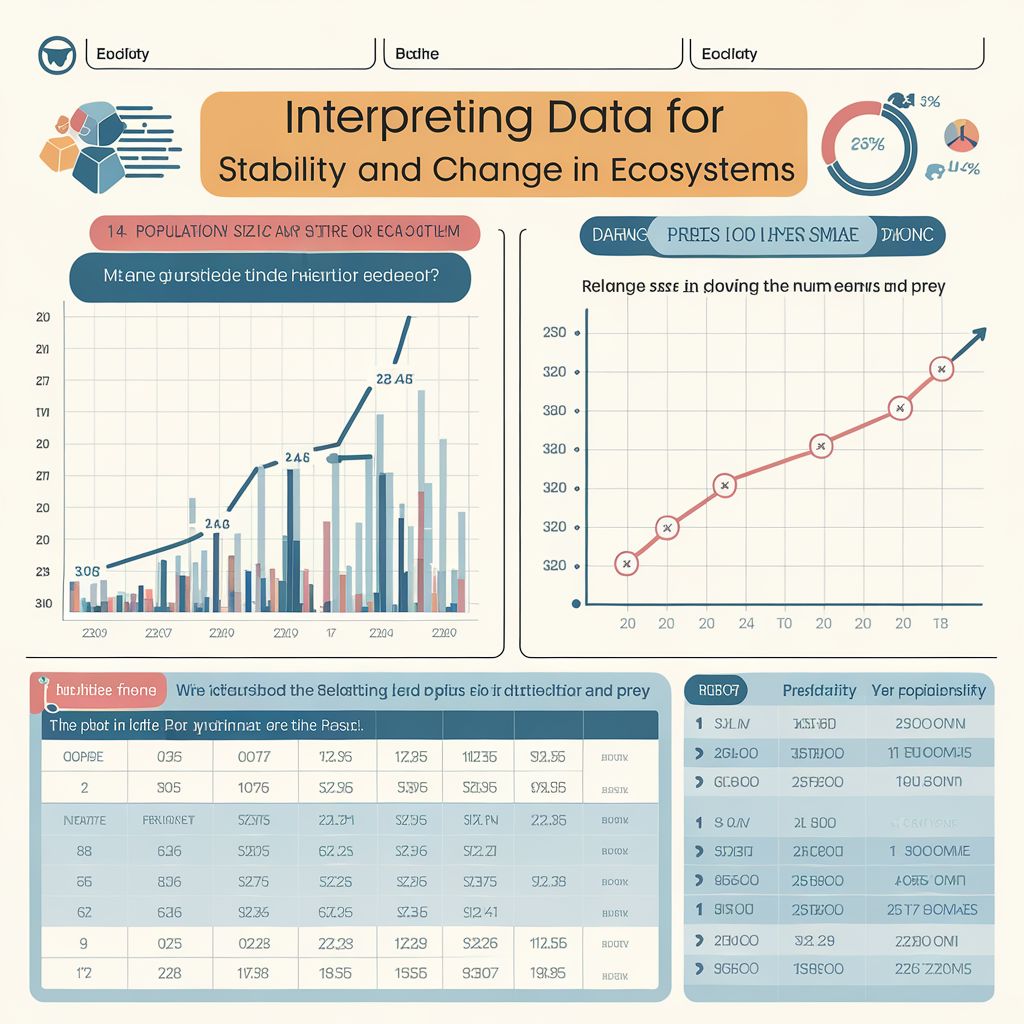Environmental and conservation research depends on knowledge of ecosystem stability and change. The ‘Interpreting Data for Stability and Change in Ecosystems Worksheet’ is a necessary instrument for this, offering a methodical way to examine ecological data, spot trends, and generate wise forecasts.
Interpreting Data for Stability and Change in Ecosystems Worksheet
Data interpretation worksheets are made to make ecological stability and change analysis easier. These resources benefit students and researchers:
- Track biodiversity and population shifts.
- Measure energy flow and nutrient cycling.
- Visualize ecological trends through graphs and charts.
- Identify critical points where ecosystems face imbalance.
There is more to these worksheets than just academic work. They offer useful information that influences resource management plans, conservation tactics, and policy decisions.
What Is an Ecosystem?
An ecosystem is the dynamic interaction of living entities—plants, animals, and bacteria—with their environment. These linkages touch ecological equilibrium, nutrient cycle, and energy flow.
For example, in a forest ecosystem:
- Through photosynthesis, trees transform sunlight into energy.
- Herbivores eat plants, giving predators energy.
- As they break down organic material, decomposers recycle nutrients into the ground.
The worksheet for evaluating data for stability and change in ecosystems captures these processes, therefore enabling a better knowledge of their intricacy.
Read More: Human impact on the environment during walks
How Do You Measure Ecosystem Stability?
Stability in an ecosystem is the capacity of it to remain balanced in the face of either internal or external pressures. Several criteria allow one to evaluate stability:
- Biodiversity:A great species variety helps to promote stability since it creates several routes for energy flow and resilience against disturbances.
- Energy Flow:Regular energy transfer among producers, consumers, and decomposers points to a healthy ecosystem.
- Resistance: The capacity of an ecosystem to withstand disturbances without transforming.
- Resilience:The speed of an ecosystem recovering from a disturbance.
By means of a worksheet for assessing data for ecosystem stability and change, researchers can quantify these elements and offer clear insights on the general state of an ecosystem.
Stability of an Ecosystem
Stability of an ecosystem is defined by its capacity to resist disturbances and maintain its vital activities. Among the most significant indicators of an environment in good condition are:
- Sustainable Biodiversity:A balance between the numbers of prey and predators.
- Resource Availability:Water, food, and shelter are always available.
- Energy Efficiency:Energy moves smoothly from producers to decomposers.
For example, symbiotic connections, like those between corals and algae, show how stable coral reefs are. The significance of stability is shown by the disruption of these interactions caused by pollution or rising sea temperatures.
How Changes Affect Ecosystem Stability
Natural occurrences, human activities, or a mix of the two can cause ecosystem changes. These modifications affect stability in the following ways:
Natural Disruptions
- Droughts, storms, and wildfires put an ecosystem’s resilience to the test.
- While certain ecosystems—like grasslands—recover swiftly, others can sustain irreversible harm.
Human Activities
- Urbanisation and deforestation cause habitat loss, which lowers biodiversity.
• Pollution affects all life forms by changing the quality of the air, water, and soil.
Climate Change
- Food availability, reproduction, and migration are all hampered by warming temperatures and changing weather patterns.
Worksheets designed for interpreting data for stability and change in ecosystems assist in determining these disturbances and their long-term effects.
Hospital Inventory Example and Ecosystem Parallels
Ecosystem dynamics and hospital inventory system management are quite comparable. Both call for flexibility, resource management, and balance.
Stable Hospital Inventory
- Frequent stock updates guarantee the waste-free and easy availability of medications, surgical supplies, and equipment.
Unstable Hospital Inventory
- While understocking results in shortages during emergencies, overstocking causes resources to expire.
- Similar to how spreadsheets assess and preserve ecological equilibrium, hospitals guarantee stability through the use of data-driven strategies, such as inventory management software.
Components of Ecosystem Worksheets
Interpreting data for stability and change in ecosystems worksheet typically includes:
- Data Tables:Arrange data about population sizes, species variety, and environmental elements like temperature and precipitation.
- Graphs and Charts:Show long-term trends, such population increase or decline.
- Critical Thinking Questions:Encourage people to assess the reasons behind and consequences of the changes they have noticed.
- Predictive Models:Using past data and present observations, make predictions about future patterns.
Classrooms, research facilities, and conservation initiatives all make extensive use of these worksheets.
FAQs
How do you measure ecosystem stability?
By evaluating energy flow, population patterns, biodiversity, and an ecosystem’s potential to tolerate and bounce back from shocks, ecosystem stability is evaluated.
What is an example of ecosystem stability?
Ecosystem stability is demonstrated by a tropical rainforest with balanced species diversity and steady energy flow.
How do changes in ecosystems affect stability?
Changes like pollution, habitat degradation, and climate change upsetting energy cycles and biodiversity lower the resilience of an ecosystem.
What is your understanding of an ecosystem?
An ecosystem is a network of interacting living entities that help to cycle nutrients and energy by means of their environment.
Why are worksheets important for ecosystem analysis?
Worksheets are essential for conservation efforts because they make it easier to arrange and evaluate data, spot trends, and forecast future changes.
What’s the connection between hospital inventory and ecosystems?
Both systems need resource management and balance. Decisions based on data preserve productivity and avoid interruptions.
Conclusion
The interpreting data for stability and change in ecosystems worksheet is a useful tool for learning how ecosystems work and react to disturbances. Researchers, students, and conservationists can use these worksheets to track patterns, recognise threats, and create plans to maintain ecological balance.
The similarities between ecosystems and other systems—like hospital inventory management—emphasize how crucial data-driven decision-making is everywhere. We can better preserve and conserve the natural world for future generations with the help of these technologies.







